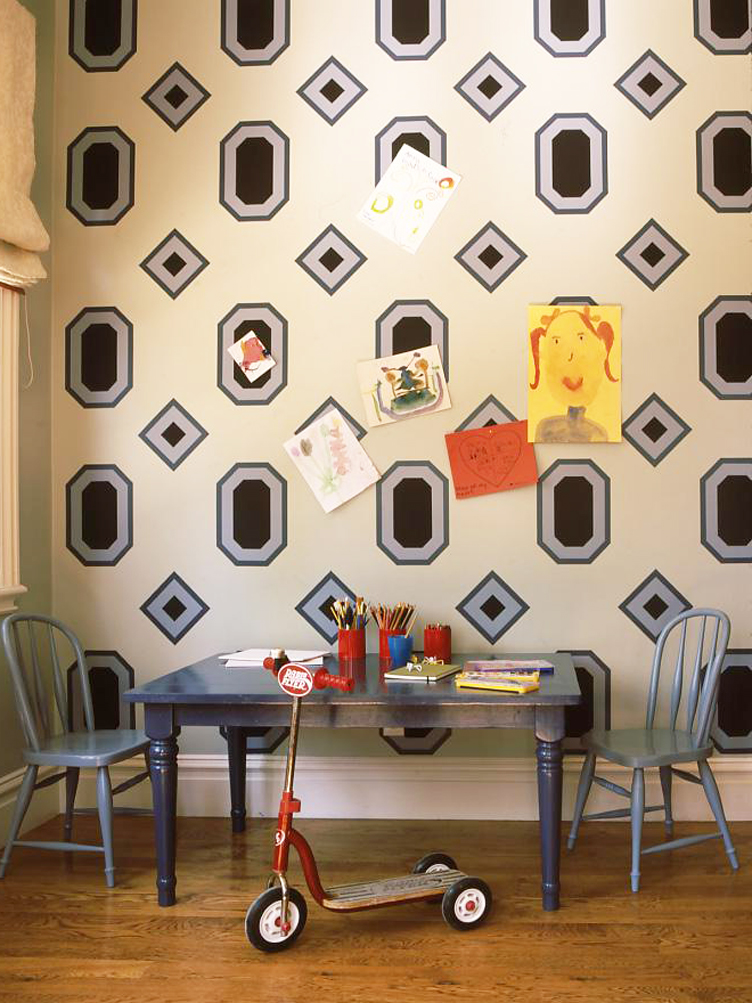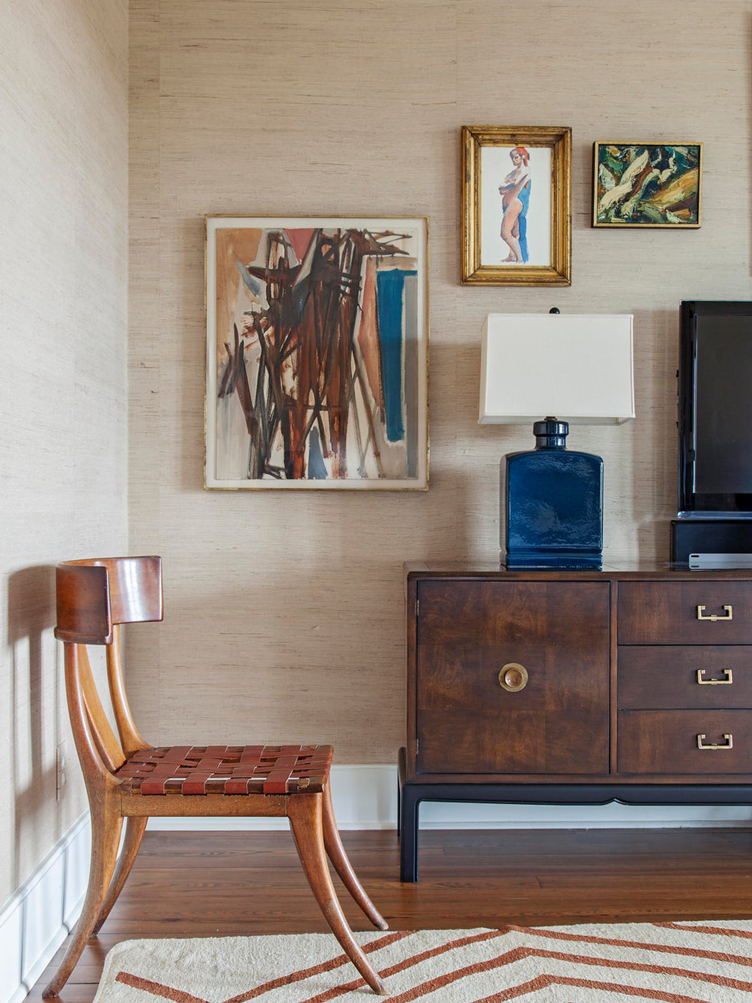As Grandmillennial style continues to accumulate followers, more and more designers and DIY-ers are getting stuck on wallpaper. Vibrantly patterned walls are analogous with the traditionalist, more-is-more design style, so it’s no surprise that contemporary wallpapers have grown from a smattering of boutique offerings to a thriving decor category. Wallpaper patterns can do more than just stun, of course—they can also paralyze the most assured DIY-ers with indecision. Not sure if chintz, checks, or a chinoiserie mural is more your style? To help, we’ve reached out to four A-list designers to break down the ins and outs of the design world’s most beloved wallpaper patterns. From geometrics to murals, these designers reveal everything you need to know about the classic wallpaper patterns that insiders are eternally glued to.
Classic Wallpaper Patterns
Toile. Chintz. Chinoiserie. These patterns may be traditional, but they’re by no means old hat. Dress your walls in any of these classical papers and they’ll be sure to enthrall.

Toile
Toile, festooned with frolicsome—and often bucolic—scenes, is among the most dynamic wallpaper patterns. Originating in the French town of Toile de Jouy in the 17th century, toile features an abundance of sketchy forms. Designers are fond of partnering toile wallpaper not only with classical decor but more neoteric designs to illicit an amusing sense of anachronism. “I think of Toile as the blue cheese on the cheese plate,” says designer Chloe Warner of the Oakland, California-based firm, Redmond Aldrich Design, “It’s not for everyone, but it can be so wonderful when done in an enveloping way.” Because toile patterns are generally refined to two colors, it’s a good choice for those who desire an allover patterned wallpaper, but not one that requires that a room be built around it. Another time designers are fond of breaking out the toile? “In rooms where the ceilings have strange pitches, toile can draw the attention away from the angles,” reveals Chloe.

Geometric
When it comes to wallpaper—especially vintage-inspired papers—patterns featuring lush, scrolling botanicals and dense trellis-work tend to dominate. But geometric papers, tame as they may seem in comparison, can pack just as much impact. Mid-Century-inspired colors and Pop Art-scale graphics can conjure the power of tile without the hassle of installation. Designers across the board love to employ geometric papers that have a retro vintage wallpaper feel, especially in kids’ rooms. Designer Chloe Warner is partial to using geometrics on a single accent wall of a kid’s room to lend viable oomph. (Insider secret: Chole looped us in that the wall treatment in the cheery playroom above was actually achieved with a stencil and magnetic paint. If wallpaper feels less DIY than you desire, this haute hack may be your calling card.)

Floral
It’s not just the echelons of design that will encourage you to take a chance on chintz. These days, designers of all inclinations are heralding the transformative powers of floral-flocked papers. Those who belong to the cult of chintz, including transcendent tastemakers Brockschmidt & Coleman, love using it on not just walls, but upholstery. “Allover floral patterns on walls, ceilings, and upholstery are traditional in rooms within the eaves,” the duo explains. In the room above they used a surplus of chintz to mask awkward asymmetry. “When the windows are oddly placed, as in this penthouse bedroom, the same pattern on the windows, walls, and ceilings is more effective and provides a romantic atmosphere,” they note. One piece of advice to heed when running floral paper overhead? Consider the direction of the paper as it extends up and across your ceiling.

Chinoiserie
Chinoiserie wallpapers are in good company. Presidential decorator Michael S. Smith, as well as designer entities like AD100 designer Alex Papachristidis, have both chosen to wrap the walls of their own homes in the botanic and avian-splashed papers. Being headquartered in New York, designing bedrooms that are soothing sanctuaries from the city bustle below is designer Kati Curtis’s specialty. Among her tricks for pulling off a bedroom that sedates? Cocooning it in chinoiserie. “The pattern truly gives a room a fantasy-like feeling,” she explains. While off-the-rack papers will certainly imbue a room with decadence, Kati’s a proponent of going handmade when you can. While she admits it can be a lot more work up front, “It’s special, and something that no one else has,” she explains. “It also allows you design control. You can add design elements in areas where art might be placed, or tone down visuals in areas that you know will be covered by furniture.”
Wallpaper Murals
For the pattern-adverse, wallpaper murals beckon. Wallpaper murals fall into one of two categories: realist and abstract. Both result in knockout walls, but you may find yourself drawn to one over the other depending on your aesthetic persuasions.

Realist Murals
While the classic patterned wallpapers outlined in the section above unquestionably provide motion, realist murals do them one better. Offering life-size graphics, realist-style murals positively enchant. “Mural wallpapers provide an atmosphere of fantasy and illusion that breaks down the geometry of a room,” say Brockschmidt & Coleman’s Bill Brockschmidt and Courtney Coleman. The duo particularly loves mural papers in dining rooms like the one above. “Because the focus is centered on the table, the food, and the diners themselves in a dining room, a mural can be an expansive, flowing backdrop,” they explain. “In this particular dining room, the herons feel like dinner companions against a brilliant pink sunset.” In rooms with more robust furniture compositions, the pair recommends that a mural be situated on a paper or architectural dado to lift the ground plane above the furniture.

Abstract Murals
Consider the verve abstract art can lend to a room and it’s easy to see why designers are ardent advocates of abstract murals. Whereas realist-style murals can make a room feel transportive, abstract murals can make it feel like you’ve entered another dimension altogether. Without an identifiable motif or repeating print, designer Kati Curtis notes that color is the largest component of most abstract wallpapers. With any paper that you’re seriously considering, note the dominant color. Ask yourself, is it a hue you would paint your walls? For a client hailing from the foothills of the Andes in South America, Kati selected an abstract mural covered in craggy peaks, backed by a rich amber hue. For her client, the attraction toward the design was intrinsic. Audacious as abstract murals can be, an emotional connection to color or form can make it significantly easier to commit.
Textured Wallpaper
Graphics aren’t the only way to procure panache. Textured wallpapers offer a sense of warmth that virtually no other wall treatment can match.

Grasscloth
The antithesis of busy papers that have you seeing double, textured wallpapers like grasscloth envelop a room. Designer Angie Hranowsky is a frequent practitioner of textured walls and counts papers like grasscloth among her go-to’s for rooms where she aims to foster a feeling of intimacy and coziness. “The nuance in tones and the three-dimensional quality that comes with a textured wallpaper is something you can’t achieve with paint or a flat finish,” explains Angie. While it can be tempting to pigeonhole textured papers as “busy” prints that are best reserved for small rooms like powder rooms, Angie advocates their usage equally in grand rooms like living rooms or dining rooms. “Grasscloth and similar papers have the ability to add a subtle texture that paint cannot provide,” she says. Try a neutral shade like camel or taupe if you still harbor reservations. You’re likely to become a convert for life.
Shop Wallpaper Patterns >>
Lead image design by Kati Curtis Design / Photo Credit: Eric Piasecki











































